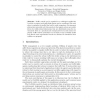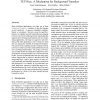76 search results - page 9 / 16 » Fluid model for window-based congestion control mechanism |
HAPTICS
2003
IEEE
14 years 23 days ago
2003
IEEE
Force-feedback mechanisms have been designed to simplify and enhance the human-vehicle interface. The increase in secondary controls within vehicle cockpits has created a desire f...
E4MAS
2006
Springer
13 years 11 months ago
2006
Springer
Traffic control can be regarded as a multiagent application in which car-agents and traffic-light-agents need to coordinate with each other to optimize the traffic flow and to avoi...
MASCOTS
2001
13 years 8 months ago
2001
Abstract--Long-range dependence has been observed in many recent Internet traffic measurements. In addition, some recent studies have shown that under certain network conditions, T...
ICC
2007
IEEE
14 years 1 months ago
2007
IEEE
— Current web applications use HTTP (Hyper Text Transfer Protocol) over TCP (Transmission Control Protocol) to retrieve objects over the Internet. SCTP (Stream Control Transmissi...
OSDI
2002
ACM
14 years 7 months ago
2002
ACM
Many distributed applications can make use of large background transfers ? transfers of data that humans are not waiting for ? to improve availability, reliability, latency or con...


